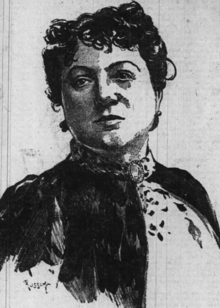Malvina Cavallazzi
Malvina Cavallazzi (born about 1852 – died October 23, 1924) was an Italian ballet dancer active in New York City and London. From 1909 to 1913, she was the first director of the Metropolitan Opera Ballet School in New York.
Early life and education[edit]
Cavallazzi was born in Ravenna, and trained as a dancer at La Scala in Milan.[1]
Career[edit]

Cavallazzi performed at La Scala in 1875, and in London in 1879. In New York City, she was part of the Mapleson Opera Troupe. "Mme. Cavallazzi has never danced more beautifully and gracefully, and gave positive pleasure," the New York Times reported of her performance at a benefit program in 1882, adding that "it would, in fact, but difficult to imagine any danseuse who could have been more perfect in her work."[2]
Cavallazzi was known for her travesti roles, including Orfeo at London's Empire Theatre of Varieties in 1891,[3] Antony in Cleopatra in 1891 at the Manchester Palace,[1] a masculine mime role in La Frolique at the Empire Theatre in 1894,[4] and Edmond Dantés in Monte Cristo at the Empire Theatre in 1896.[5] She was a member of Colonel Mapleson's Opera Company in England.[1] Critic Arthur Symons found that she was "not by any means without talent," but that "she so deliberately and resolutely overdoes everything she has to do as to absolutely tire one's eyes."[1]
Cavallazzi was the first director of the Metropolitan Opera Ballet School, beginning in 1909.[6][7] She also taught in London. Her students included Eva Swain,[8] Phyllis Bedells,[9] Marjorie Bentley,[10] and Winifred Hart-Dyke.[11][12] "When I teach dancing it is to the mind, not to the legs, that I give my attention," she explained in 1913. "If the mind is quick to catch a suggestion, the feet will follow fast enough."[13]
Personal life[edit]
Cavallazzi married English theatrical manager Charles Mapleson; he died in 1893.[14][15] She died in 1924, in Ravenna. There is a Via Malvina Cavallazzi in Ravenna, named in her memory.
References[edit]
- ^ a b c d Pritchard, Jane (2003). "'More Natural Than Nature, More Artificial Than Art': The Dance Criticism of Arthur Symons". Dance Research. 21 (2): 63–64, 86, 87 note 37. doi:10.3366/3594051. ISSN 0264-2875.
- ^ "Amusements: Signor Campanini's Benefit". The New York Times. 1882-04-25. ISSN 0362-4331. Retrieved 2023-04-08.
- ^ "Empire Theatre" (PDF). Dancing. 1 (1): 11. June 8, 1891.
- ^ Donohue, Joseph W.; Donohue, Joseph (2005). Fantasies of Empire: The Empire Theatre of Varieties and the Licensing Controversy of 1894. University of Iowa Press. p. 68. ISBN 978-1-58729-643-7.
- ^ "'Monte Cristo' at the Empire". Sketch. 16: 50. November 4, 1896.
- ^ Zeller, Jessica (2016-08-01). "Ballet's Traditionalists: Malvina Cavallazzi and Luigi Albertieri". Shapes of American Ballet: Teachers and Training Before Balanchine. doi:10.1093/acprof:oso/9780190296681.003.0005.
- ^ Cather, Willa Sibert (October 1913). "Training for the Ballet: Making American Dancers". McClure's. 41: 85–95.
- ^ Neal, Maude H. (1912-10-06). "The First American Premiere Danseuse is Little Eva Swain, Aged Fifteen". The Pittsburgh Press. p. 41. Retrieved 2023-04-09 – via Newspapers.com.
- ^ Genné, Beth (1995-01-01). "Openly English: Phyllis Bedells and the birth of British Ballet". Dance Chronicle. 18 (3): 437–451. doi:10.1080/01472529508569217. ISSN 0147-2526.
- ^ "Training Children for the Grand Opera Ballet". The New York Times. 1911-10-08. p. 47. Retrieved 2023-04-09 – via Newspapers.com.
- ^ St.-Johnston, Sir Reginald (1906). A History of Dancing. Simpkin, Marshall, Hamilton, Kent, & Company. p. 125.
- ^ "American Dancers Show Their Skill; Pupils of Mme. Cavallazzi, Trained for the Metropolitan, Win Applause". The New York Times. June 29, 1910. p. 7. Retrieved April 9, 2023 – via TimesMachine.
- ^ "'American Girls are Marvels of Sylphlike Grace and Sinuousness--and They're Intelligent" Says". The Pittsburgh Press. 1913-07-13. p. 9. Retrieved 2023-04-09 – via Newspapers.com.
- ^ "Mr. Charles Mapleson". Nottingham Evening Post. 1893-11-21. p. 2. Retrieved 2023-04-09 – via Newspapers.com.
- ^ "Charles Mapleson Dead; A Man Well Known Hero in Italian Opera Days at the Academy". The New York Times. 1893-11-22. ISSN 0362-4331. Retrieved 2023-04-09.
External links[edit]
- "Malvina Cavallazzi instructing students of the Metropolitan Opera Ballet" (1910 photograph), in the New York Public Library Digital Collections, Jerome Robbins Dance Division

